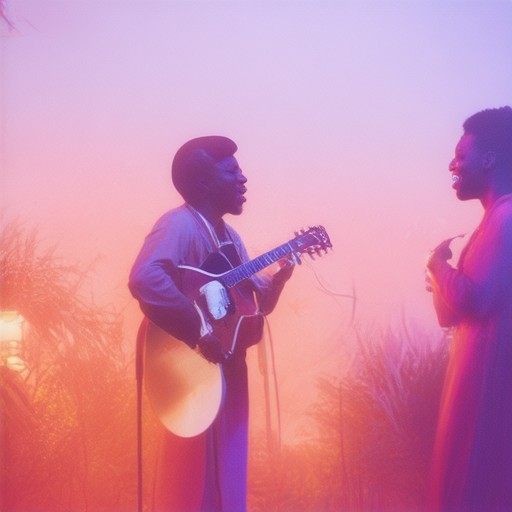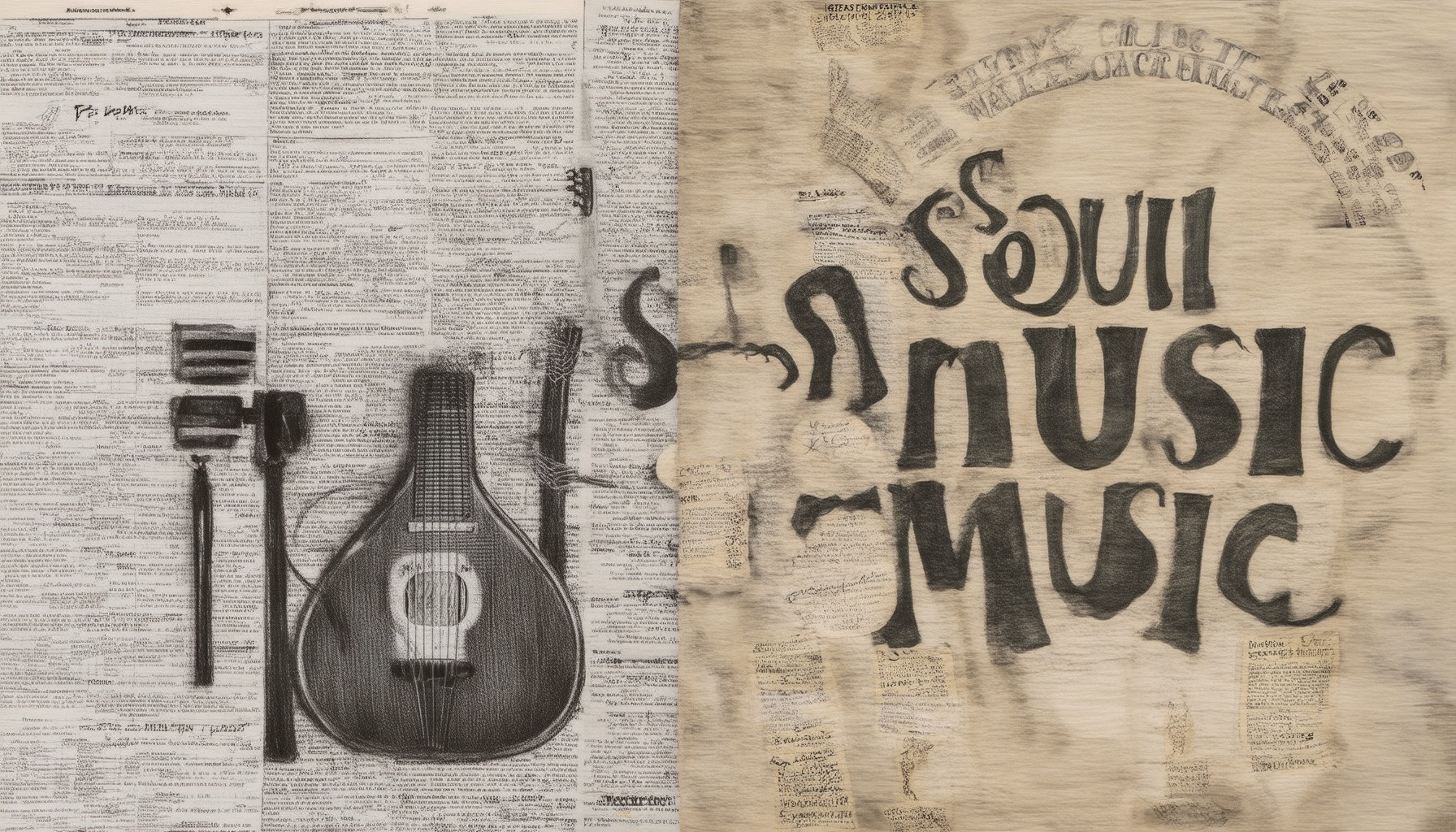Soul music has long been recognized as a powerful medium for preserving and celebrating the rich tapestry of human culture. At its core, soul music serves as a vessel for storytelling traditions, offering a unique way to document and pass down historical narratives, cultural heritage, and communal experiences. From its origins in African American tradition, soul music has evolved into a global phenomenon, weaving intricate stories through its melodies, lyrics, and emotional depth. This article delves into how soul music plays a pivotal role in preserving storytelling traditions, connecting cultural identities, and influencing global narratives. By exploring the ways in which soul music incorporates storytelling, we uncover its profound impact on shaping our collective memory and fostering connections across generations.
Key Takeaways
- Soul Music Masterpieces Tell Compelling Stories: Soul music crafts vivid narratives through powerful lyrics and emotive instrumentation, resonating with listeners on a deep level.
- Vibrant Lyrics Paint Universal Truths: Artists like Aretha Franklin and Otis Redding transform personal struggles into relatable tales, creating music that speaks to everyone.
- Instruments Enhance Emotional Depth: The Hammond organ, horns, and tight rhythms mirror African storytelling traditions, adding layer upon layer to the musical narrative.
- Engaging Performances Foster Connection: Soul performances invite audiences into the story, creating an intimate and shared experience that feels deeply personal.
- Rooted in Rich Cultural Heritage: Drawing from blues, gospel, and jazz, soul music preserves and celebrates the history of African American communities.
- A Living Tradition Inspires Modern Artists: From D’Angelo to Jazmine Sullivan, soul music continues to evolve while honoring its legacy, connecting today’s audiences with yesterday’s stories.
- More Than Just Music: Soul is a bridge between generations, preserving history and inspiring future generations to keep telling their tales through music.

How Does Soul Music Preserve Storytelling Traditions?
Soul music plays a vital role in preserving storytelling traditions by serving as a vessel for cultural heritage and communal narratives. Its expressive nature allows artists to convey emotions, histories, and experiences, often passed down through generations.
- Oral Tradition Extension: Soul music continues the legacy of oral storytelling by translating life lessons, moral tales, and personal journeys into musical form. Artists often draw inspiration from historical events, personal experiences, and societal issues, creating songs that resonate as stories.
- Cultural Reflection: Soul music reflects the struggles, triumphs, and collective consciousness of communities. It serves as a medium for expressing the human condition, making abstract concepts tangible and relatable through rhythm and melody.
- Emotional Expression: Soul music excels in conveying complex emotions, which are often tied to storytelling. Whether it’s the blues telling tales of heartbreak or hip-hop recounting urban experiences, the genre thrives on narrative depth.
- Community Bonding: In many African American communities, soul music has been a tool for preserving history and fostering unity. It bridges generations, allowing older stories to be retold and new ones to emerge.
- Artistic Innovation: Soul musicians have consistently pushed boundaries, creating new forms of storytelling through their music. This innovation ensures that traditional tales are reinterpreted for contemporary audiences while staying true to their original intent.
Tiger Funk celebrates this legacy with in-depth articles and artist profiles that explore the intersection of soul music and storytelling. Explore our collection to discover how this art form continues to preserve and evolve traditional narratives.
For more insights, visit Tiger Funk and dive into our articles on the cultural significance of soul music and its role in shaping modern storytelling.
How Do Soul Music Storytelling Traditions Connect With Cultural Heritage?
Soul music storytelling traditions deeply intertwine with cultural heritage, serving as a powerful medium to preserve, celebrate, and pass down the histories, values, and identities of communities. These traditions go beyond mere entertainment, functioning as a vessel for collective memory and cultural transmission. Here’s how soul music connects with cultural heritage:
- Preserving Histories Through Powerful Narratives : Soul music often carries the weight of historical and social narratives. Artists like Aretha Franklin, Otis Redding, and Nina Simone used their voices to express the struggles, hopes, and aspirations of African Americans during the Civil Rights era and beyond. Their songs became anthems for movements, documenting the journey toward freedom and equality while also reflecting personal and collective experiences.
- Embedding Cultural Values and Wisdom : Many soul songs incorporate wisdom, lessons, and moral tales passed down through generations. For instance, the likes of Curtis Mayfield and Sam Cooke wrote music that addressed themes of love, resilience, and social justice, embedding cultural values that resonate deeply with listeners. These songs become part of the cultural fabric, shaping the way future generations understand their heritage.
- Fostering Community and Identity : Soul music acts as a unifying force, bringing people together through shared experiences and emotions. Festivals, concerts, and even street performances often become spaces where cultural heritage is celebrated and reaffirmed. The shared enjoyment of soul music strengthens communal bonds and reinforces a sense of belonging to a cultural group.
- Reflecting Regional and Global Influences : Soul music is a product of its time and place, drawing from African American roots while also absorbing influences from Latin, Caribbean, and global musical styles. This hybridity reflects the dynamic nature of cultural exchange, showcasing how soul music has evolved while staying true to its core cultural essence.
- Connecting Generations : Soul music bridges the gap between past and present, connecting older generations who lived through significant historical events to younger audiences who may not have experienced those times firsthand. This intergenerational connection helps sustain cultural heritage, ensuring that stories and values continue to be shared and understood.
- Inspiring Artistic Evolution : Soul music has influenced countless genres, from hip-hop to rock, while remaining a cornerstone of cultural expression. Its legacy ensures that the storytelling traditions of soul music continue to thrive, inspiring new artists to explore and celebrate their own cultural heritage.
At Tiger Funk, we celebrate the profound connection between soul music and cultural heritage, offering deep dives into the history and impact of this vital art form. Explore our articles and artist profiles to uncover the ways soul music continues to shape and reflect the world around us. Discover how these traditions live on, enriching our lives and fostering a deeper appreciation for the cultures that gave rise to them.

How Do Soul Music Storytelling Traditions Connect With Cultural Heritage?
Soul music storytelling traditions deeply intertwine with cultural heritage, serving as a powerful medium to preserve, celebrate, and pass down the histories, values, and identities of communities. These traditions go beyond mere entertainment, functioning as a vessel for collective memory and cultural transmission. Here’s how soul music connects with cultural heritage:
- Preserving Histories Through Powerful Narratives : Soul music often carries the weight of historical and social narratives. Artists like Aretha Franklin, Otis Redding, and Nina Simone used their voices to express the struggles, hopes, and aspirations of African Americans during the Civil Rights era and beyond. Their songs became anthems for movements, documenting the journey toward freedom and equality while also reflecting personal and collective experiences.
- Embedding Cultural Values and Wisdom : Many soul songs incorporate wisdom, lessons, and moral tales passed down through generations. For instance, the likes of Curtis Mayfield and Sam Cooke wrote music that addressed themes of love, resilience, and social justice, embedding cultural values that resonate deeply with listeners. These songs become part of the cultural fabric, shaping the way future generations understand their heritage.
- Fostering Community and Identity : Soul music acts as a unifying force, bringing people together through shared experiences and emotions. Festivals, concerts, and even street performances often become spaces where cultural heritage is celebrated and reaffirmed. The shared enjoyment of soul music strengthens communal bonds and reinforces a sense of belonging to a cultural group.
- Reflecting Regional and Global Influences : Soul music is a product of its time and place, drawing from African American roots while also absorbing influences from Latin, Caribbean, and global musical styles. This hybridity reflects the dynamic nature of cultural exchange, showcasing how soul music has evolved while staying true to its core cultural essence.
- Connecting Generations : Soul music bridges the gap between past and present, connecting older generations who lived through significant historical events to younger audiences who may not have experienced those times firsthand. This intergenerational connection helps sustain cultural heritage, ensuring that stories and values continue to be shared and understood.
- Inspiring Artistic Evolution : Soul music has influenced countless genres, from hip-hop to rock, while remaining a cornerstone of cultural expression. Its legacy ensures that the storytelling traditions of soul music continue to thrive, inspiring new artists to explore and celebrate their own cultural heritage.
At Tiger Funk, we celebrate the profound connection between soul music and cultural heritage, offering deep dives into the history and impact of this vital art form. Explore our articles and artist profiles to uncover the ways soul music continues to shape and reflect the world around us. Discover how these traditions live on, enriching our lives and fostering a deeper appreciation for the cultures that gave rise to them.

How Does Soul Music Incorporate Storytelling Traditions Into Its Performances?
Soul music is renowned for its ability to weave intricate storytelling traditions into its performances, creating a deeply emotional and connective experience for audiences. This art form thrives on expressing narratives through lyrics, instrumentation, and delivery, often drawing from rich cultural and personal histories.
One prominent aspect of soul storytelling is the use of vivid, relatable lyrics that paint pictures of everyday struggles, triumphs, and emotions. Artists like Aretha Franklin and Otis Redden masterfully crafted tales that resonate with listeners, turning personal experiences into universal truths. Their performances often feel like a conversation between the artist and the audience, making the listener an active participant in the narrative.
Instrumentation plays a significant role in soul storytelling too. The Hammond organ, horns, and tight rhythm sections provide a foundation that complements the emotional depth of the songs. These sounds echo traditional African storytelling traditions, where rhythm and melody were essential tools for conveying messages and fostering community.
Another key element is the interactive nature of soul performances. The artist often engages the audience, inviting them to become part of the story. This dynamic interaction strengthens the emotional bond between the performer and the listener, creating a shared experience that feels intimate and profound.
Soul music’s storytelling traditions also borrow from various cultural influences, including blues, gospel, and jazz. These genres taught artists how to use space, timing, and dynamics to convey emotion effectively. The result is a performance style that balances technical skill with raw, authentic expression.
Ultimately, soul music’s ability to tell stories through music transcends mere entertainment—it becomes a bridge between past and present, connecting generations with timeless narratives. This tradition continues to inspire new artists who seek to honor the legacy while carving their own path in the soulful tapestry of music history.
How Does Soul Music Incorporate Storytelling Traditions Into Its Art Form?
Soul music is renowned for its ability to weave intricate storytelling traditions into its art form, creating deeply emotional and relatable narratives through music. This tradition is rooted in the African American experience, where music has long served as a vessel for expressing personal and collective struggles, triumphs, and hopes.
1. Emotional Expression and Personal Narratives
- Soul musicians often craft emotional narratives that resonate with listeners on a profound level. By infusing their music with personal experiences, they create a sense of authenticity that draws audiences in. For instance, Aretha Franklin’s “Respect” isn’t just a song about love—it’s a declaration of self-worth and empowerment, told through her powerful vocals and the raw intensity of the performance.
2. Narrative Structure in Songs
- Many soul songs follow a three-act structure, mirroring the arc of a story. This approach allows artists to guide listeners through a journey, building tension and releasing it toward a cathartic climax. Marvin Gaye’s “What’s Going On” masterfully uses this technique, weaving together themes of social injustice, personal loss, and hope.
3. Cultural Roots and Community Stories
- Soul music often reflects the cultural tapestry of African American communities. It serves as a medium for preserving histories, traditions, and shared experiences. The Isley Brothers’ “Shades of Black” is a prime example, blending spiritual themes with social commentary to tell a story that resonates beyond individual lives.
4. Collaboration and Group Dynamics
- In soul music, collaboration often becomes a storytelling tool itself. The way artists like Curtis Mayfield and The Impressions layered harmonies in tracks like “We Got to Have Peace” creates a layered narrative, where each voice contributes to the overall message. This collaborative approach mirrors the communal nature of storytelling within African American culture.
5. Live Performances as Extended Narratives
- Soul music thrives in live settings, where performers can extend stories beyond the confines of a recorded track. James Brown’s performances, for example, were legendary for their ability to transport audiences, turning venues into settings where his music—and the stories it told—came alive.
6. Technological Influences on Storytelling
- As soul music evolved, technological advancements allowed artists to experiment with sounds that amplified the emotional impact of their stories. Prince’s use of synths and drum machines in tracks like “Purple Rain” created a cinematic quality, where every note felt like a chapter turn in a larger narrative.
7. Legacy and Evolution
- Today, soul music continues to influence contemporary artists who seek to preserve and expand upon these storytelling traditions. Artists like D’Angelo and Jazmine Sullivan draw inspiration from the era’s emphasis on authenticity and narrative depth, crafting music that feels both timeless and relevant.
For deeper exploration of soul music’s storytelling traditions, visit Tiger Funk to discover articles, artist profiles, and album reviews that celebrate the genre’s rich heritage.

How Does Soul Music Weave Storytelling Traditions Into Its Compositions?
Soul music is renowned for its ability to craft compelling narratives through its compositions, drawing from a rich tapestry of storytelling traditions. This art form thrives on expressing deep emotions, personal experiences, and societal reflections, often encapsulated in powerful melodies, evocative lyrics, and rich instrumental arrangements.
Storytelling Through Lyrics
Soul musicians frequently employ lyrical storytelling to convey personal journeys, social commentary, and emotional struggles. Artists like Aretha Franklin and Otis Redding used their music to articulate the trials and triumphs of everyday people, creating relatable and profound narratives. Their words paint vivid pictures, allowing listeners to connect with the stories being told.
Emotional Expression in Melody and Harmony
The essence of soul music lies in its ability to evoke emotion. Composers and vocalists often infuse their pieces with raw, unfiltered feelings, transforming simple melodies into powerful storytelling tools. The way singers deliver a song, whether through a soaring alto or a guttural growl, adds layers of meaning and intensity to the narrative.
Cultural and Historical Context
Soul music emerged from a culture steeped in storytelling traditions, particularly the African American oral tradition. This legacy is evident in the way musicians like Sam Cooke and Stevie Wonder crafted their songs, often drawing from personal experiences and broader societal issues. The music becomes a mirror reflecting the struggles and aspirations of communities.
Instrumentation as Narrative Support
From the punchy horns of New Orleans to the intricate piano solos of Motown, the instrumentation in soul music often complements the storytelling. Each instrument contributes to the overall mood, whether it’s the driving bassline grounding a ballad or the uplifting choir adding a sense of collective joy.
Legacy and Influence
Soul music’s storytelling tradition has left an indelible mark on subsequent genres. Artists across pop, rock, hip-hop, and jazz have drawn inspiration from its ability to convey complex emotions and weave intricate tales. The medium remains a powerful vessel for human experiences, connecting generations through shared narratives.
A Conclusion on Soul Music’s Storytelling Power
Soul music is more than just music—it’s a medium for storytelling. It captures the essence of human experience, transforms personal struggles into universal truths, and celebrates the beauty of life. By mastering these traditions, soul musicians continue to create works that resonate deeply with audiences, proving that music truly speaks to the soul.
Tiger Funk explores these themes in-depth, delving into the history of soul music and its enduring impact on storytelling. Check out our articles on the history of soul music and its role in storytelling for a deeper dive into this artistic tradition.
Competitors like Rolling Stone and Billboard also cover soul music’s storytelling traditions, offering additional perspectives worth exploring.





0 Comments